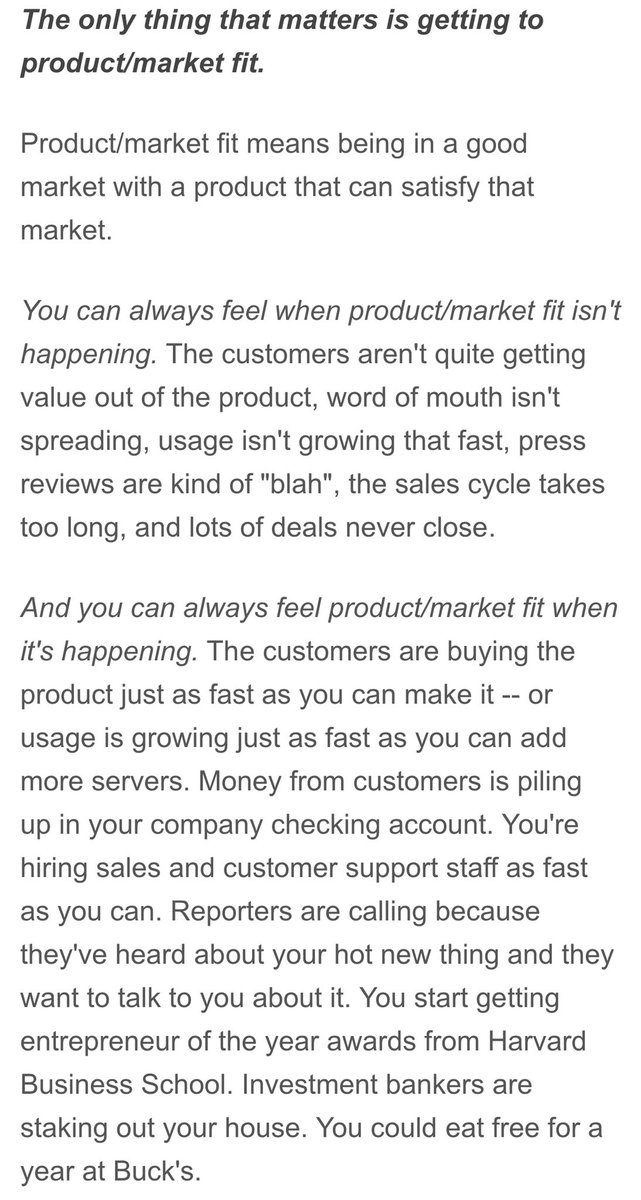This is a never ending thread of the very best online content and resources for early stage startups.
Relevant for both self-funded/bootstrapped and venture backed pre-seed/seed stage companies.
Relevant for both self-funded/bootstrapped and venture backed pre-seed/seed stage companies.
The blog posts from 2008 on @ericries’ blog are a must-read for startup founders. They describe the basics for building online businesses. Timeless and useful content, regardless of your opinion about lean startup. startuplessonslearned.com/2008/
This video on “How to Operate” by @rabois should be required for every startup founder to watch and internalize. Especially useful for founders who are new to management.
Trying to understand product/market fit? Start here. This is a copy of @pmarca’s original timeless 2007 blog post about product/market fit. pmarchive.com/guide_to_start… 

Startups need early believers. In 2009, @sparker wrote this email to @eldsjal and @shak. There isn’t a better example of an early startup believer. Sean believed because of what the original @Spotify team was able to create and ship to the world. scribd.com/doc/67465758/S…
This timeless article from 2018 by @ashleymayer explains exactly how startups should be thinking about PR and communications. She worked at @Box for 6 years during @levie’s rise to becoming twitter famous as an enterprise founder/ceo. medium.com/@ashleymayer/i…
If you can set aside your opinion about what Facebook is today and watch this interview you’ll see an example of a founder with a growth mindset. In particular, @finkd’s comments at the end about focusing intensely on customer experience are instructive.
Strategy is critical at the earliest stages of a business. The three tasks that @joulee recommends to do more of describes exactly what an early stage startup team should be doing to be strategic. medium.com/the-year-of-th…
Also, her book on management is 🔥 amzn.to/2PRwCyW
Also, her book on management is 🔥 amzn.to/2PRwCyW
Working on a SaaS business? Avoiding the 🐘 in the room? The P word? Pricing. This is your savior: @Patticus and @lennysan teamed up to create this step-by-step paint-by-numbers how to guide to put an end to all those pricing fears and debates. Forever. lennyrachitsky.com/p/saas-pricing…
I often hear early stage startup teams say they have done “no marketing.” That’s not accurate. Startups are marketing, even when they think they aren’t. Here’s an explanation by @Steli about what marketing actually means. Let’s set the record straight. blog.close.com/killing-the-st…
Bookmark this for when you’re looking for a co-founder. @eriktorenberg breaks the whole process down in this step-by-step how to guide: eriktorenberg.substack.com/p/how-to-find-…
When you're trying to figure out the go-to-market (GTM) strategy for a B2B company, this deck by @carolinedclark is exactly what you need. docs.google.com/presentation/d…
Trying to understand investors and the fundraising process? This guide by @NFX will set you straight. nfx.com/post/the-non-o…
Co-Founder and CEO of @Drift, David Cancel, is obsessed with storytelling. He's a 5X founder who cares deeply about internal company culture. This is his eye-opening perspective: firstround.com/review/how-thi…
Anyone who is working on or thinking about a referral program for their SaaS product needs to read this thread.
https://twitter.com/_shahedk/status/1367532457075957761
• • •
Missing some Tweet in this thread? You can try to
force a refresh





